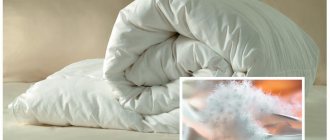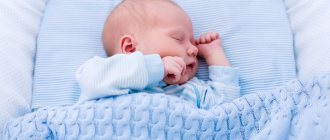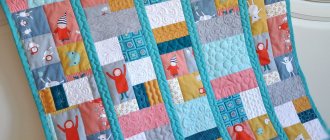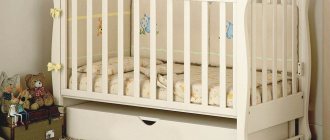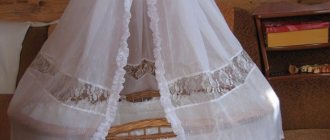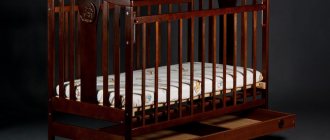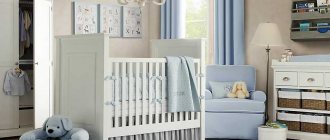Every loving parent wants to provide their child with the best, so before you buy any item for your child, you need to know everything about it thoroughly. Which blanket to choose for a newborn? The question is quite serious, because such a thing should not only warm the baby, but also be safe and comfortable. This article will tell you about all the main nuances of choosing this bed textile.
Which blanket is best for a newborn's crib?
First of all, parents must take into account one important fact - the time of year when the child was born. Depending on this, the choice will be different blankets:
- If it is cold autumn or winter, then the following options are suitable for the child: cotton, down, wool or fur blankets.
- If it is a warm spring or summer, then it is better to buy a blanket made of thin fleece or flannel. A nice wool blanket will also come in handy.
At the same time, young parents should understand that when buying a blanket for the summer, they will also have to buy a second one for the winter, and vice versa. Therefore, do not delay your purchase; it is better to buy the necessary set of blankets right away.
Types of blankets for newborns
Standard blanket
Standard blankets for newborns are designed for children of different ages. Some models are suitable only for the first year of life, while others can be used from birth until three or four years. For example, blankets measuring 100x140 and 110x140 can be used for babies 0–3 years old, and models measuring 80x110 can be used for children up to one year old.
Blankets for newborns are made from different materials: bamboo fiber, camel wool, linen, fleece, cotton, down and padding polyester. There are winter and summer models (with and without fillers), as well as products designed for all seasons.
Envelope blanket
Such products have a standard envelope shape, but if necessary they can be folded into a regular blanket. They can be used for discharge from the hospital or for a walk, as a regular blanket or play mat.
The envelopes are lightweight and easy to fold. There are different sizes, most often it is 75x75, 90x90 or 110x110. Natural fabrics (100% cotton) and anti-allergenic insulation are used in production.
Envelopes can be winter, summer, demi-season and all-season. All-season models come complete with a fur blanket, which is used together with an envelope in the cold season.
How to choose a baby blanket? Primary requirements
A newborn does not have its own immunity, so increased demands are placed on such products. The first blanket for a baby must have the following qualities.
- Breathability. Bedding for infants should only be made from breathable materials. Even a less active child can wrap a blanket around himself while sleeping, so for safety reasons the product must be well breathable.
- Hypoallergenic. In the first days and months of a child's life, it is very difficult to predict which materials may cause allergic reactions in him. For this reason, the blanket should be made from environmentally friendly materials; it should not attract dust, mites and create favorable conditions for the development of fungi and mold.
- Hygroscopicity and thermal conductivity. The child’s body, unlike the adult human body, is not able to adapt to the ambient temperature. To prevent a newborn from sweating during sleep, from freezing or overheating, his blanket should have the ability to absorb evaporation from the skin as quickly as possible and remove it outside, while remaining dry.
- Light weight and soft. The baby's skin is very sensitive, so it should not be damaged by the dense, strong and rough material of the blanket. In this case, it is better to choose a blanket for a newborn that will be pleasant to the touch and that will not put pressure on the baby.
- Easy to care for. To maintain the hygiene of products that surround the child, they should be washed and washed regularly. This applies to blankets, so it's best if the item is machine washable.
Basic sizes for newborns
How to choose the right size blanket for a newborn? It is selected according to the size of the crib with a small margin. A blanket that is too large in a small crib will disturb the baby. It's hot to sleep under and there's a high risk of overheating.
If the baby is active, then he may find himself covered with his head. In this case, it is advisable to purchase side clamps for the crib. Conversely, a small, narrow and short blanket can constantly slide down, revealing the baby. The choice of the required size depends on the height and age of the baby. The sizes are:
- 80x90 cm.
- 95×100 cm.
- 90x120 cm.
- 100x140 cm.
- 105x115 cm.
- 120×120 cm.
- 110×140 cm.
The standard sizes are 110x140 cm and 100x135 cm, and for cradles - 80x90 cm.
Which blanket is best for a newborn in winter?
Let's consider the best options for children's blankets that can warm a child during the cold season.
Pooh
. This material is used as blanket filler for people of all ages.
Advantages:
- It is characterized by lightness, good breathability, and remarkably warms.
- It is recommended to use such a blanket in rooms where the air temperature does not exceed +16-+18 degrees.
Important! If the room temperature is higher than specified, there is a possibility of the baby overheating.
Flaws:
- This filler is susceptible to infection by feather mites, the activity of which can provoke severe allergies in a child.
- A product with down requires periodic drying, as it absorbs moisture well.
Cotton
Another popular filling for blankets for newborns is natural cotton and cotton wool.
Advantages:
- Cotton is a hypoallergenic material, so there is no need to worry about any problems associated with the child's reaction to the filling.
- This blanket is capable of excellent heat retention, preventing the child from overheating.
Flaws:
- The fairly noticeable weight of the blanket can create some discomfort for the baby.
- Over time, the batting may clump. Such blankets will end up being uncomfortable - they will lose their thermal properties and eventually become unusable.
- Cotton is good at absorbing moisture, so this product also requires periodic drying.
Wool
Woolen products can be of two options: in the form of a blanket and in the form of a bedspread. When choosing a blanket for a newborn from this material, you should give preference to a quilted wool product.
Advantages:
- This blanket is light weight, so it will be comfortable for the child.
- Wool keeps warm very well, so parents should not worry that the baby will freeze at night.
- A child can use this product for about 8 years or even more. Throughout this period, the blanket will not lose its thermal characteristics and beautiful appearance.
- Under such a blanket, the baby will not sweat, since the material is hygroscopic and evaporates moisture well.
- The wool blanket has good breathability.
Flaws:
- A significant disadvantage of wool products is the allergic nature of the material.
Important! If after the first night a child spends under such a blanket, he develops a rash or other manifestations of allergies, then the woolen product cannot be used in the future.
Synthetics
Many parents refuse to purchase synthetic products, preferring only natural materials for their baby. However, in cases where a newborn suddenly develops an allergy to filling, such as down or wool, a synthetic blanket is an ideal replacement.
Advantages:
- Products with synthetic filler are quite easy to care for. This item can be washed in a washing machine.
- The weight of the blanket is light, so the child will be comfortable under it in this regard.
Flaws:
- Synthetics do not allow heat to pass through, so it can be quite hot for a baby to sleep wrapped in such a blanket.
Bamboo
This blanket is perfect for a newborn, but it also has its downside, which is very important for many parents.
Advantages:
- The bamboo blanket is thin, pleasant to the touch (silky), and perfectly maintains a temperature that is comfortable for the baby’s body.
- The service life of such a product is quite long, the blanket is durable and reliable.
- The blanket is hypoallergenic and antibacterial, which is very important for the baby’s sensitive body.
Flaws:
- The only drawback is the high cost of the blanket. Not all parents will be able to buy such a product for their child without significantly emptying their wallet.
Choice for winter
The main condition for choosing a winter option is warmth and good air circulation. It shouldn't be too hot or too cold under the winter blanket. Which blanket to choose for a newborn for the winter season? Common options for winter include wool, down, synthetic, bamboo and cotton wool.
Woolen
Wool blankets for small children are made from camel and sheep wool. These can be blankets or quilts. Quilted ones are preferable, since the wool in them is evenly distributed, does not bunch up and does not cake after washing. Its advantages also include:
- ease;
- heat;
- durability;
- hygroscopicity;
- breathability.
The disadvantage is allergenicity. If your baby develops an allergy or skin irritation after contact with a woolen product, you should immediately stop using it. Woolen items can harbor moths.
Down
Bird down (swan, goose, loon) is used to fill duvets. It has good quality characteristics:
- ease;
- breathability;
- They keep you warm.
Which blanket to choose for a newborn's crib in the summer?
A summer blanket should be breathable, light, soft and easy to care for. The most popular options for such products are the following.
Bike
Products made from yarn are well known to our grandmothers, as they wrapped our mothers and fathers in the material. It is not surprising that the material has retained its popularity to this day, because its merits are undeniable.
Advantages:
- The blanket is soft, light in weight, and can quickly take the shape of a child's body, providing comfort while sleeping.
- The product allows air to pass through perfectly, so the baby does not sweat and does not develop diaper rash.
- The flannel blanket is hypoallergenic.
- Under such a blanket you will be warm even on the coolest summer or spring evenings.
- The product does not require special care, so it can be easily washed with baby laundry detergent or regular laundry soap.
- The appearance of the product can vary greatly. You can choose colors for girls and boys.
- The durability of the flannelette blanket and its affordable price are the main advantages of this version of the product for bedding for a newborn.
Calico
If one of the important criteria for choosing blankets for newborns is natural material, then you can safely give preference to a blanket made of calico.
Advantages:
- Ease,
- This blanket is made from environmentally friendly materials, so it is safe for the baby’s sensitive body.
- It has a low degree of creasing, so it retains its beautiful appearance even during intensive use.
- Strength. A calico blanket can retain its original pattern for several years.
Fleece
This material is a synthetic knitted fabric. She has become a part of our lives because she is practical. When it comes to choosing a fleece blanket for your baby, there are pros and cons.
Advantages:
- The fleece blanket is almost weightless.
- The material is hypoallergenic.
- A fleece blanket does not require special care, is easy to wash and dry quickly, and does not undergo biological degradation over time.
Flaws:
- The material quickly accumulates dust, which can cause an allergic reaction.
Choice for the summer
In summer, do not wrap your baby in a warm blanket. Overheating is even more dangerous for a child than hypothermia. A baby blanket should be very light, almost weightless, made from pleasant soft fabrics, breathable and hygroscopic. Which blanket to buy for a newborn for the summer season?
Baykovoe
Flannelette blankets are made from natural material and therefore are often purchased for the summer. Their advantages include:
- hypoallergenic;
- lungs;
- soft;
- breathable;
- colorful;
- washes well;
- durable;
- inexpensive.
Calico
Calico is considered an ecological material that combines:
- ease;
- durability;
- almost does not wrinkle.
Fleece
A fleece blanket is a knitted fabric. An airy fleece blanket will create a comfortable temperature regime. The advantages of such a product include:
- ease;
- easy care;
- not subject to biological destruction.
- dry quickly.
When choosing a fleece item for a child, you need to know that fleece absorbs dust and therefore can cause allergies.
Woolen.
How to choose a baby blanket for warmth?
Very few modern parents know that the thermal characteristics of any blanket are indicated on its packaging. This is done using dots. Let's see what exactly does the number of dots on the package mean?
- 5 points. This label indicates the highest level of warmth of the blanket.
- 4 points. Simple, comfortable, warm blankets have this designation.
- 3 points. A blanket designed for spring or autumn.
- 2 points. Lightweight blanket for standard home temperatures.
- 1 point. This blanket is only suitable for the warm summer season.
Important! To buy a truly safe product for your baby, ask the seller for a quality certificate. It must be on any product sold in the store. If there is no certificate, then it is better to refuse to purchase this product.
Characteristics: advantages and disadvantages of the material
Fleece has a number of advantages, the most valuable of which, if we consider the material as a raw material for a children's blanket, are:
- antibacterial. Dust mites, microorganisms and mold fungi do not multiply in it, and moths do not eat it;
- hypoallergenic. The material is non-allergenic and, due to its antibacterial properties, prevents the occurrence of allergic reactions;
- breathability. The texture of the material is such that it has a huge number of air cavities, this does not interfere with air exchange;
- thermoregulatory properties. The material provides excellent warmth and retains heat;
- wear resistance. A fleece blanket is durable, it retains its properties and appearance for a long time;
- lightness - the canvas is very light, even a high-density blanket can be handled by a child without any effort;
- removes moisture well. The blanket does not absorb excess moisture, but removes it out;
- dries incredibly quickly (the blanket dries in two to three hours after machine washing);
- low cost;
- tactile comfort. The blanket is very soft, delicate, pleasant and comfortable to the touch, it is not scratchy like natural wool and hard and creaky like many synthetic materials;
- very easy to care for. Easy to wash, does not absorb odors, dries quickly, no need to iron.
The only disadvantage we can note is that fleece is prone to accumulating static electricity and periodically “shoots”, but this problem is easily solved by treating it with antistatic agents.
Is the baby warm?
First of all, the blanket should provide good protection from the cold. Models with cotton filling are often not recommended for children. Such a product cannot be washed; it is difficult to find a dry cleaner that will undertake to put it in order. You can immediately reject this filler, and then bitterly regret your decision.
We recommend: How to choose a comfortable pillow for pregnant women?
In many cities in winter, problems with heating often arise: either the steam supplied to the radiators is too cold, or the pumping station will fail in severe frosts. It's cold for both adults and children. This is where a cotton blanket will help you out. It may be heavy and difficult to care for, but this model will save your baby from the cold. Buy your baby such bedding, and no mistakes of the management company will make him freeze.
If your apartment is constantly cold, buy a wool blanket. It is hygroscopic and absorbs sweat well, but when purchasing, you need to touch the product and determine its cruelty. The wool must be well processed so that it is not itchy and does not contain splinters, thorns and other foreign inclusions. If you are not buying a woven blanket, but a cover with stitched wool filling, pay attention to the label. The density of the stuffing determines how warm the baby will be under such a blanket. For apartments with poor heating system performance in winter, you need to stay at 420 g/m2.
Advice
When choosing a wool blanket, focus only on softness and warmth. All information about radiation protection, the healing effect and the effects of lanolin from the hair of various animals on the skin is a common advertising gimmick.
Wool is considered a light filler, but if you want your baby to be warm and not feel the weight of the blanket at all, choose a model made of holofiber or padding polyester. These materials can be washed and do not harbor harmful insects. If you are going on a trip, the product can be compactly packed, it will not take up much space, and its weight is almost imperceptible. Such things can be safely packed and sent to the mezzanine for the summer; moths won’t eat them.
